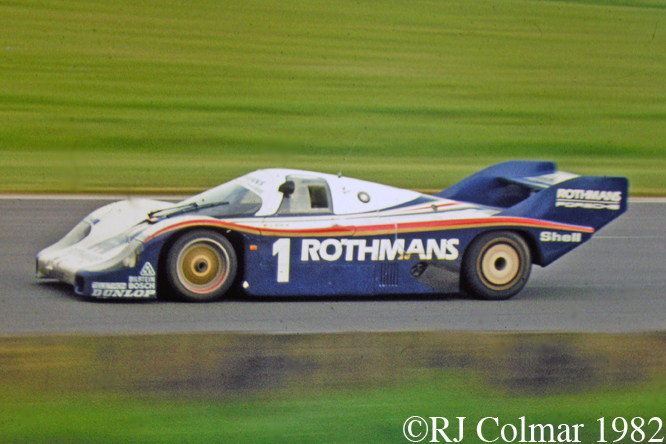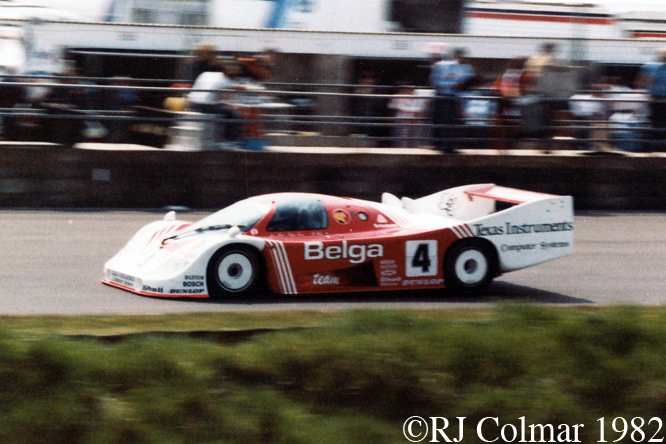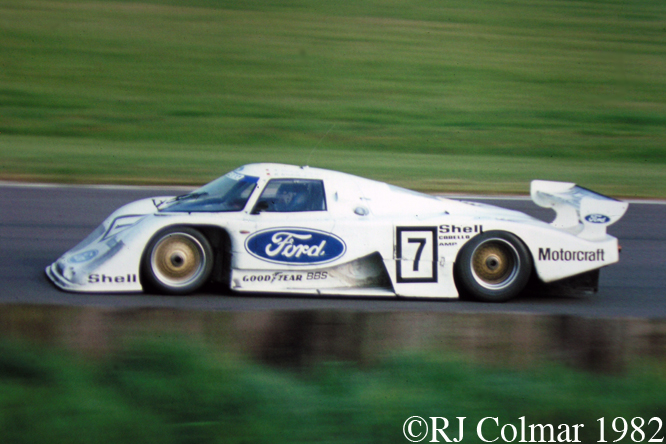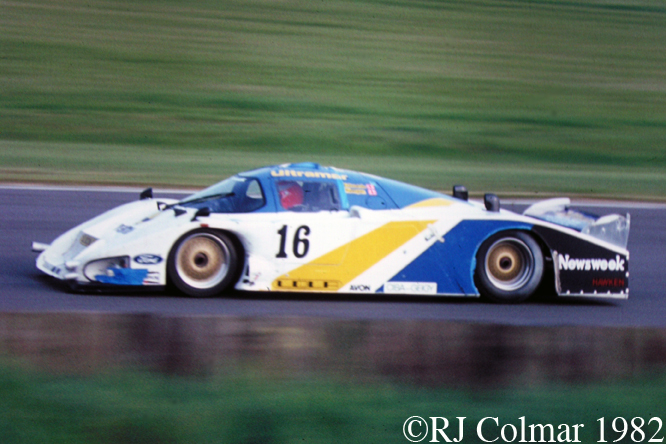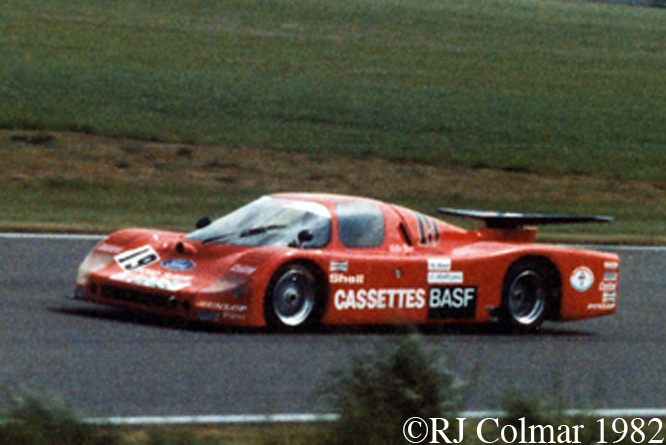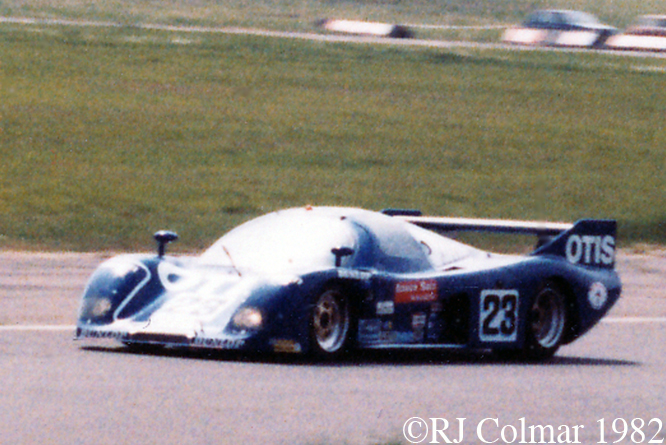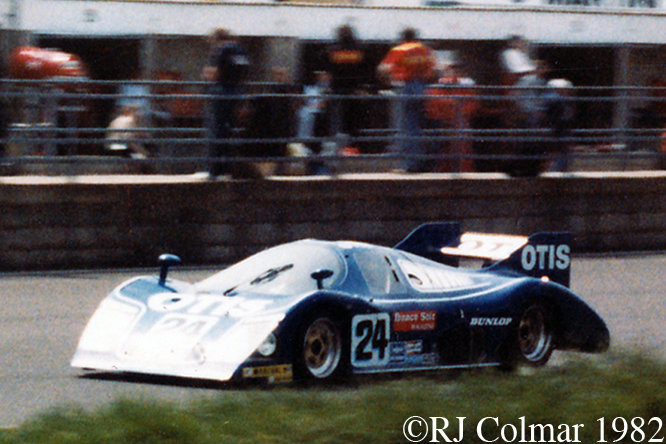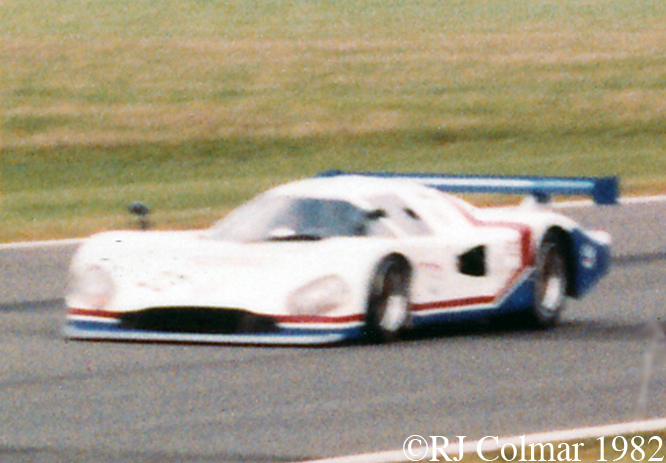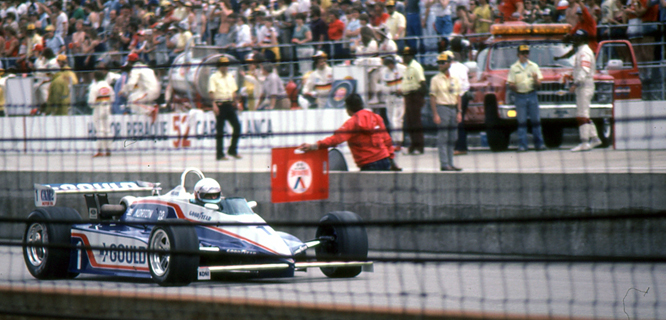On May the 16th 1982 I awoke excitied to catch my first glimpse of a new endurance sports car series at Silverstone. The Group C series was born out of the GT Prototype class which had hitherto run only at Le Mans for closed cockpit 2 seat cars with just safety features, some overall limits on dimensions and a limited amount of fuel for rules. Here is a summary of a few Group C cars I saw that day.
It took three years for the series to really take off with support from three manufacturers but for that first year in 1982 Porsche were prepared in particularly overkill fashion with the Porsche 956 which used a 650 hp twin turbo charged 2.65 litre / 156 cui flat 6 motor that had originally been conceived for the banned 1980 Interscope Porsche Indy Car.
The motor was successfully tested in preparation for Group C in the back of two Porsche 936’s at Le Mans in 1981, Ickx and Bell scoring an emphatic win by 14 laps. Featuring an aluminium monocoque the 956 was designed to take full advantage of ‘ground effect’ aerodynamic technology that had been developing in Formula One since 1976.
Uniquely among the first generation of Group C cars the 956 had been tested in exactly the same way as all Porsche road car designs meaning it alone among it’s competitors could negotiate potted and cobbled streets with out any noticeable detriment to the integrity of the chassis or performance of the motor. Like the Porsche 935 and 936 models it replaced the 956 was utterly dominant in the first 3 years of Group C, sweeping aside a puny effort from Lancia who competed with the Ferrari powered Lancia LC 2 from 1983 to 1985, not having any real competition until the arrival of Jaguar in 1985. Quite simply the 956 nearly killed the series as in 1983 the first of 28 customer 956’s started to fill out the grid.
However Porsche did not have it quite their own way, in 1982, as Lancia sort to wrest the World Sports Car Drivers Championship from Porsche drivers by entering a couple of cars built to the old open top regulations, which had one year left to run, these open Group 6 cars did not need to adhere to the fuel consumption regulations of Group C. Lancia won three races outright including the Porsche 956’s debut race at Silverstone. However Lancia driver Ricardo Patrese was eight points short of winning the title which went to Jacky Ickx who shared the #1 956 seen at Silverstone above with Derek Bell. At Le Mans in 1982 the works Porsche team led by Ickx and Bell took 1,2,3 victory.
Chassis #001 driven here by Icks and Bell easily qualified on pole but constrained by the fuel allowance in the race meant they finished 3 laps behind the race winning Group 6 Lancia LC1. #001 was used on two further occasions, as a test car at Le Mans and in the 200 mile Norisring German Racing Championship (DRM) race which it won with Jochen Mass at the wheel, before it was retired.
In 1983 Ickx retained his World Endurance Drivers title, before handing it over to team mate Stefan Bellof in in 1984. Ickx retired from racing in 1986 after a fatal accident involving Bellof now driving for the private Brun Team at Spa in 1986.
Derek Bell shared the World Endurance Drivers title in 1986 and 1987 driving Porsche 962’s with team mate Hans-Joachim Stuck on both occasions.
While Porsche customer teams like Joest and Kremer had to wait until 1983 before being able to purchase customer Porsche 956’s with which to compete in the new series, neither sat idle in 1982 both teams building Group C cars of their own devising using Porsche engines.
Of the two the Joest team car was the first to compete, built around a Joest built Porsche 936 chassis #JR005 with a smaller 2.1 litre / 128 cui twin turbo flat 6 motor. The 936C driven by Frenchman Bob Wollek, and the Belgian Martin brothers, Jean-Michell and Philippe, finished third on it’s debut at Silverstone and continued to be a top ten finisher in Group C events until the end of 1986 when it was effectively outlawed by new footwell regulations.
Joest would become the Porsche factories team of choice whenever the works team was not present at the track. Joest cars won Le Mans in the absence of the factory team in 1984 and 1985 with the same 956B chassis #117, one of the few chassis to win the 24 hour marathon twice. Joest repeated the feat in 1996/1997 winning with Le Mans with the same TWR/Porsche. Joest Racing then became with the über successful Audi and Bentley campaigns that have dominated Le Mans since the turn of the century.
Bob Wollek never won the Le Mans 24 hour race but he did win the Daytona 24 hour race four times. Three of them driving the 956 successor Porsche 962’s.
Fords involvement in the series proved a little half hearted despite the involvement of Len Terry in the design and a Cosworth V8 DFL motor based on the 3 litre / 183 cui DFV but now stretched to 4 litres / 244 cui. The larger motors sounded frankly awful and suffered from excessive vibrations that hindered reliability.
Manfred Winklehock and Klaus Ludwig, who is seen at the wheel here, qualified 4th but could only finish eighth in the race. The C100’s only wins were recorded by Klaus Ludwig in the German DRM championship and by the end of 1982 Ford called a halt to it’s Group C programme.
Peer Motorsport acquired the two time DRM winning C100 chassis #04 for 1983, it was mostly raced in the British Thundersport Series where it recorded one further victory in the hands of Irishman David Kennedy and Scotsman Jim Crawford at Donington Park.
Klaus Ludwig would go on to join the Joest Team and won the 1984 and 1985 Le Mans driving the 956B chassis 117 sharing the driving with Henri Pescarolo in 1984 and Paolo Barilla and ‘John Winter’ in 1985.
WM was founded by two Peugeot design studio employees in 1969 Gerard Welter and Michel Meunier in 1969 who in their spare time built two cool coupe’s the first WM P69 was based on a Peugeot 204 Cabriolet platform and the second WM P70 was a mid engined design.
Their next effort the WM P76 was built to the Le Mans GTP regulations first announced in 1976 was powered by a Peugeot/Renault/Volvo (PRV) V6 stock block. Over the next 13 years they built 7 distinct models adding twin turbo’s the PRV motors in 1977. In 1980 they scored a best 4th place and first in GTP at Le Mans.
The WM P82 took part in 5 Group C races, Roger Dorchy, Jean Daniel Raulet and Michel Pignard driven car is seen above on the WM teams second ever outing abroad, it qualified 39th and finished 11th. The WM teams best 1982 result was on it’s first trip abroad to Monza where it qualified 11th and came in 6th. The teams natural reliance on the PRV block was probably it’s down fall for all though eventually tuned to give over 900 hp in 1988 it was actually designed to initially produce 150 to 200 hp.
Sensing that a win at Le Mans was not in their grasp by 1987 WM focused on becoming the first team to reach 400 km/h on the legendary 3.1 mile Mulsanne straight during the 24 hour race. With the engine producing 950 hp and all the cooling blanked off and special Michelin tyres the WM P88 of Roger Dorchy was timed at 405 km/h / 253 mph at 9pm in the evening of the 1988 race. This record will probably stand for all time given that in 1990 2 chicanes were added to the straight to slow the cars down. Rogers car unsurprisingly retired from the race with overheating issues.
WM made way for for an official Peugeot Works team in 1990, in 199O Gerard Welter took over the team completelu renaming it WR (Welter Racing), which scored a class win at Le Mans in 1993 and sensationally locked out the front row of the grid at Le Mans in 1995.
Lola’s involvement with Le Mans dates back to a contract with Ford to develop the fabled GT40, racing under it’s own name it has never won Le Mans. The T610 was powered by the same 4 litre / 244 cui Ford Cosworth DFL as the Ford C100, but proved even more unreliable, despite qualifying 8th at Silverstone, Guy Edwards and Rupert Keegan who is seen in the car here could manage only a 16th place finish.
The T610’s best result of the season was a 7th place finish at Brands Hatch. Lola would hook up with Nissan to produce several Group C Le Mans challengers at the end of the 1980’s including the outright qualifying lap record holding Nissan R90CK which held the record at 3m 27 secs from 1990 until 2008.
Guy Edwards would become a mover and shaker in Group C when he lent his considerable sponsorship finding talents towards the Jaguar Group C project run by Tom Walkinshaw Racing.
The Sauber SHS C6 was another Ford powered Group C contender and predictably unreliable Walter Brun and Seigfried Muller Jr qualified 12th and finished 13th after loosing the rear wing. The teams best result, a 4th place finish came during a DRM race at Hockenheim. The an SHS6 running in the privateer C2 class appeared in the Group series until 1986.
Peter Sauber hooked up with Mercedes Benz unofficially in 1986 and by 1987 started getting works support leading to a victory at Le Mans and the World Sportscar Championship in 1989. Sauber went on to become a Mercedes Powered Formula One constructor returning the famous manufacturer to the top tier of the sport in 1993 after a 38 year break.
In 1983 Walter Brun ended up taking over the GS Sport Company that had been operating in partnership with Sauber in 1982. His operation eventually became a Porsche customer team running 956’s and then the replacement 962’s with which Brun Motorsport won the 1986 World Sports Prototype Championship. By 1992 the team folded after a dabbling in the disastrous EuroBrun Formula One project and attempting to build his own Judd powered Le Mans challenger.
Le Mans based Group C team Rondeau like WM started out competing at the 24 hour classic in the GTP class in 1976 winning the GTP class in both 1976 and 1977 under the Inaltera name.
In 1978 the team which always used 3 litre 183 cui Ford Cosworth V8 motors now raced under the founder, Jean, Rondeau’s own name. Jean Rondeau with Bernard Darniche and Jacky Haran scored his second Le Mans GTP class victory with an M378 and in 1979 the team won the unlimited sports prototype class at Le Mans going one better in 1980 with and overall Le Mans victory for Jean Rondeau and Jean-Pierre Jaussaud.
Another Le Mans GTP class victory, 2nd overall, followed in 1981 for Haran, Phillipe Streif and Jean Louis Schlesser
Like Ford, Lola and Sauber, Rondeau plumped for the Cosworth DFL but somehow found some reliability where others had failed Pescarolo and Gorgio Francia indeed won the first ever Group C race, at Monza, with a Rondeau M382. Pescarolo and Gordon Spice seen above at Silverstone qualified 9th and finished 5th.
This same car won it’s class, 2nd overall, at the Nurburgring with Pescarolo and Rolf Stommelen at the wheel.
While the #23 M382 Rondeau was based on a design that could trace it’s origins back to the 1976 Inaltera the Rondeau team fielded a second design which should have taken advantage of the prevailing ground effect technology of the period unfortunately on it’s debut at Silverstone Jean Rondeau and Francois Migault could only qualify 27th and failded to finish after bodywork and suspension breakages. The car failed to appear at Le Mans and when it appeared in 1983 it was with heavily revised bodywork.
The Rondeau scored more points in Group C than any other team in 1982 but Porsche were allowed to have points accumulated by a car running in a lower GT class added to their points tally and were declared 1982 World Endurance Champions, Rondeau’s sponsor OTIS announced it’s immediate withdrawal from the team in disgust.
With no significant sponsorship Rondeau concentrated all of it’s efforts on Le Mans for 1983 all three DFL powered revised M482’s retired with motor related issues an only the Christian Bussi teams car recorded a finish, a lack luster 19th.
Rondeau’s team folded at the end of 1983 and Jean was killed by a train in a bizarre accident while following police car over a level crossing in 1985. Rondeau cars continued to appear in Group C races at Le Mans and elsewhere until 1987.
Finally while certainly not the last of the Group C cars that appeared at Silverstone in May 1982 the Nimrod NRA/C2 is notable because it featured an Aston Martin Tickford V8 motor, from the Vantage V8 model, which sounded fantastic in comparison with the Cosworth DFL V8 and the flat 6 Porsche. The private #32 Viscount Downe entry seen here driven by Ray Mallock and Mike Salamon qualified three places better than the works entry in 11th and finished 6th while the works car retired.
Through out 1982 the Viscount Downe entry out qualified the works entry usually by three places and manged a finish which the works entry never did. The Aston Martin Owners Club president Viscount Downe Team finishes secured a third place finish for Nimrod Aston Martin in the 1982 World Endurance Championship behind Porsche and Rondeau, with the more successful Lancia running in the old Group 6 class it was ineligible to score points in the manufacturers championship.
Both Nimrod teams continued into 1984 with the works team running AJ Foyt, Darrel Waltrip and Guillermo Maldonado in a Pepsi Challenger liveried example in the Daytona 24 Hours. However with ever more Porsche 956’s filling the grid and a distinct lack of reliability the works team folded in 1983 and the Viscount Downe team in 1984.
Ray Mallock would eventually run the Ecurie Ecosse team in the lower Group C2 class taking the class title in 1986 before overseeing the return, to Group C, of a fully works backed Aston Martin project in 1989. For 1990 Ray was involved with the Nissan R90CK project. His team has won numerous touring car titles with Vauxhall, Nissan and Chevrolet for whom he currently runs the successful works World Touring Car Championships cars.
Due to a concerted attempt to become an adult and various unavoidable associated commitments, weddings, graduation and such like it would be three years before I attended another Group C race, when I came back Group C was really taking off with Jaguar entering the fray and efforts from other teams like Toyota and Mercedes (Sauber) beginning to gather momentum. By the end of 1992 I had attended more than a dozen Group C races and seen some fantastic battles all of which will have to wait for future editions of GALPOT.
Thanks for joining me on this “Thirty Years Ago #2” edition of ‘Gettin’ a li’l psycho on tyres’ I hope you will join me again tomorrow when I’ll be looking at the Simply Italian parade at the National Museum as originally promised yesterday. Don’t forget to come back now !

